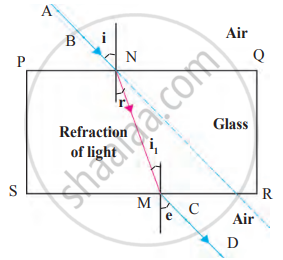Advertisements
Advertisements
प्रश्न
Observe the given figure and name the following.

| Ray AB | |
| Ray NM | |
| Ray MD | |
| ∠ r |
उत्तर
| Ray AB | Incident ray |
| Ray NM | Refracted ray |
| Ray MD | Emergent ray |
| ∠ r | Angle of refraction |
संबंधित प्रश्न
Name the phenomenon responsible for the following effect:
When we sit in front of a plane mirror and write with our right hand, if appears in the mirror that we are writing with the left hand.
If an object is placed at a distance of 10 cm in from of a plane mirror, how far would it be from its image?
State whether the following statement is true of false:
A student says that we can see an object because light from our eyes is reflected back by the object.
Where is the image when you look at something in a mirror?
A boy with a mouth 5 cm wide stands 2 m away from a plane mirror. Where is his image and how wide is the image of his mouth?
The boy walks towards the mirror at a speed of 1 m/s. At what speed does his image approach him?
An extended object in the form of an arrow pointing upward has been placed in front of a plane mirror. Draw a labelled ray-diagram to show the formation of its image.
State the uses of plane mirrors.
Define the following terms used in the study of reflection of light by drawing a labelled ray-diagram:
(a) Incident ray
(b) Point of incidence
(c) Normal
(d) Reflected ray
(e) Angle of incidence
(f) Angle of reflection
Write all the capital letters of the alphabet which look the same in a plane mirror.
The angle of reflection is equal to the angle of incidence:
(a) always
(b) sometimes
(c) under special conditions
(d) never
The image formed by a plane mirror is :
(a) virtual, behind the mirror and enlarged.
(b) virtual, behind the mirror and of the same size as the object.
(c) real, at the surface of the mirror and enlarged.
(d) real, behind the mirror and of the same size as the object.
The figure given alongside shows the image of a clock as seen a plane mirror. The correct time is:
Figure
(a) 2.25
(b) 2.35
(c) 6.45
(d) 9.25
If a ray of light goes from a rarer medium to a denser medium, will it bend towards the normal or away from it?
State two effects caused by the refraction of light.
As light rays pass from water into glass, are they refracted towards the normal or away from the normal?
Fill in the following blank with suitable word:
Light bends when is passes from water into air. We say that it is ............
Light travels more quickly through water than through glass.
Which is optically denser : water or glass?
With the help of a diagram, show how when light falls obliquely on the side of a rectangular glass slab, the emergent ray is parallel to the incident ray.
Explain with the help of a labelled ray diagram, why a pencil partly immersed in water appears to be bent at the water surface. State whether the bending of pencil will increase or decrease if water is replaced by another liquid which is optically more dense than water. Give reason for your answer.
Water is optically denser than glass.
The speed of light is more in glass than in water.
Image is formed by a mirror due to refraction of light.
Air is optically .......... than glass.
Explain how the formation of a rainbow occurs.
Lights of different colours are used as signal for safety transport. From these, the wavelength of red light is _______ nm.
Write scientific reason.
The bottom of a pond appears raised.
Write scientific reason.
The coin disappears in a vessel as it is seen from a specific location. But as soon as the water is poured into the vessel to a certain level, the coin appears.
Why does a ray of light bend when it travels from one medium to another?
Numerical problems.
The speed of light in water is 2.25 × 108 ms–1. If the speed of light in vacuum is 3 × 108 ms–1, calculate the refractive index of water.
The refractive index of a transparent medium is always greater than ______.
Assertion and reasoning type
- Assertion: If the refractive index of the medium is high (denser medium) the velocity of the light in that medium will be small
- Reason: Refractive index of the medium is inversely proportional to the velocity of the light
If a beam of red light and a beam of violet light are incident at the same angle on the inclined surface of a prism from air medium and produce angles of refraction r and v respectively, which of the following is correct?

The angle of incidence from air to glass at the point O on the hemispherical glass slab is.
Which object use the reflection of light?
Which surface will not reflect most of the light falling on them?
Light travels fastest in a vacuum. Why?
In refraction of light through a glass slab, the directions of the incident ray and the refracted ray are ______.
